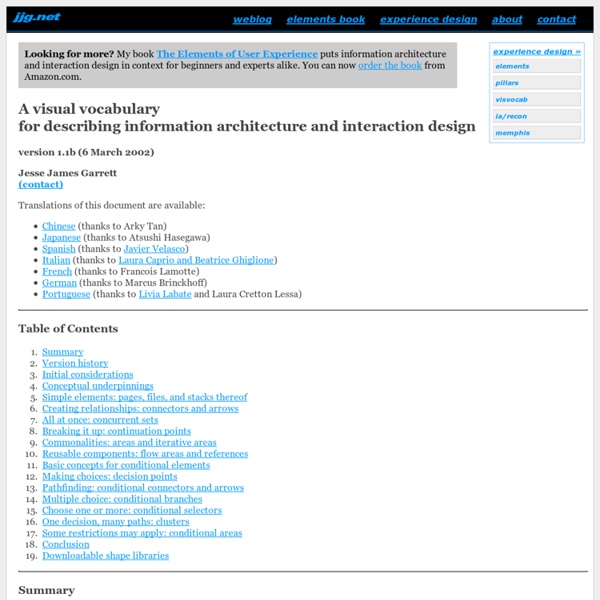Jesse James Garrett: Visual Vocabulary for Information Architecture

Alertbox: Jakob Nielsen's Newsletter on Web Usability
10 Usability Heuristics for User Interface Design April 24, 1994 | Article: 2 minutes to readJakob Nielsen's 10 general principles for interaction design. They are called "heuristics" because they are broad rules of thumb and not specific usability guidelines. When to Use Which User-Experience Research Methods October 12, 2014 | Article: 8 minutes to readModern day UX research methods answer a wide range of questions.
Uncovering and Exploring Usability Issues from Experience Dynamics Founder
Jakob Nielsen Biography
Jakob Nielsen, Ph.D., is a User Advocate and principal of the Nielsen Norman Group which he co-founded with Dr. Donald A. Norman (former VP of research at Apple Computer). Dr. Nielsen established the "discount usability engineering" movement for fast and cheap improvements of user interfaces and has invented several usability methods, including heuristic evaluation. Jakob Nielsen has been called: "the king of usability" (Internet Magazine) "the guru of Web page usability" (The New York Times) "the next best thing to a true time machine" (USA Today) "the smartest person on the Web" (ZDNet AnchorDesk) "the world's leading expert on Web usability" (U.S. Usability Articles Since 1995, Dr. Subscribe to the Alertbox newsletter Books Professional Background Jakob Nielsen holds a Ph.D. in human–computer interaction (HCI) from the Technical University of Denmark in Copenhagen. From 1994 to 1998 he was a Sun Microsystems Distinguished Engineer. Dr. In June 2000, Dr. Profiles Parodies See Also
Subtraction
Jesse James Garrett: experience design and information architecture resources
What reading Tufte won't tech you :: interface design
Edward Tufte’s books do a beautiful job of illustrating how to present huge amounts of information clearly and simply. Well presented information is critical to good interface design, but it’s not the whole story. I’ve just spent two months carrying a terrible, ancient cellular phone and a mediocre non-Apple music player around the planet, and interacting almost exclusively with Windows XP terminals at internet cafes and hostels. Read on for explanations and examples of good and bad design related to each one of these rules. The application interface should be fast and non-blocking. The application interface should be consistent. Don’t interrupt users in the middle of common, nondestructive tasks.The basic, core functionality of the application should be free from confirmations, interruptions, dialog boxes, configuration questions, multiple steps, wizards, and other garbage. Avoid notifying users of success. Avoid giving users information that they cannot use.
Jesse James Garrett: jjg.net
Institut pour l'architecture de l'information
Ergonomie web et logiciel, architecture de l'information, utilisabilité sites Internet – Ergolab
Recette de test utilisateur, Partie 1
Introduction Cet article propose une recette de test utilisateur. On peut parler de recette parce que mettre en place un test nécessite de passer par plusieurs étapes. Comme pour les recettes de cuisine, la dextérité vient avec l'expérience. Comprendre l'importance des tests utilisateurs n'implique pas de pouvoir les conduire. La façon de conduire un test utilisateur dépend en grande partie du budget accordé à l'ergonomie dans le projet. » Pré-requis Notre présentation part du principe que l'on a pris connaissance de l'interface et identifié les objectifs du projet. Le choix de la méthode du test suppose que le projet soit d'ampleur suffisante pour l'avoir fait précéder d'autres analyses (consultation libre des utilisateurs, tri de cartes, analyse des tâches, analyses concurrentielles, inspection experte d'une interface existante…). Nous détaillons dans cet article les étapes sous-jacentes à la conduite d'un test utilisateur classique. 1. 2. 3. » Echantillonnage » Combien de participants ?
Related:
Related:



